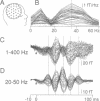Abstract
Spontaneous oscillatory electrical activity at a frequency near 40 Hz in the human brain and its reset by sensory stimulation have been proposed to be related to cognitive processing and to the temporal binding of sensory stimuli. These experiments were designed to test this hypothesis and to determine specifically whether the minimal interval required to identify separate auditory stimuli correlates with the reset of the 40-Hz magnetic signal. Auditory clicks were presented at varying times, while magnetic activity was recorded from awake human subjects. Experimental and modeling results indicate a stimulus-interval-dependent response with a critical interval of 12-15 ms. At shorter intervals only one 40-Hz response, to the first stimulus, was observed. With longer intervals, a second 40-Hz wave abruptly appeared, which coincided with the subject's perception of a second distinct auditory stimulus. These results indicate that oscillatory activity near 40 Hz represents a neurophysiological correlate to the temporal processing of auditory stimuli. It also supports the view that 40-Hz activity not only relates to primary sensory processing, but also could reflect the temporal binding underlying cognition.
Full text
PDF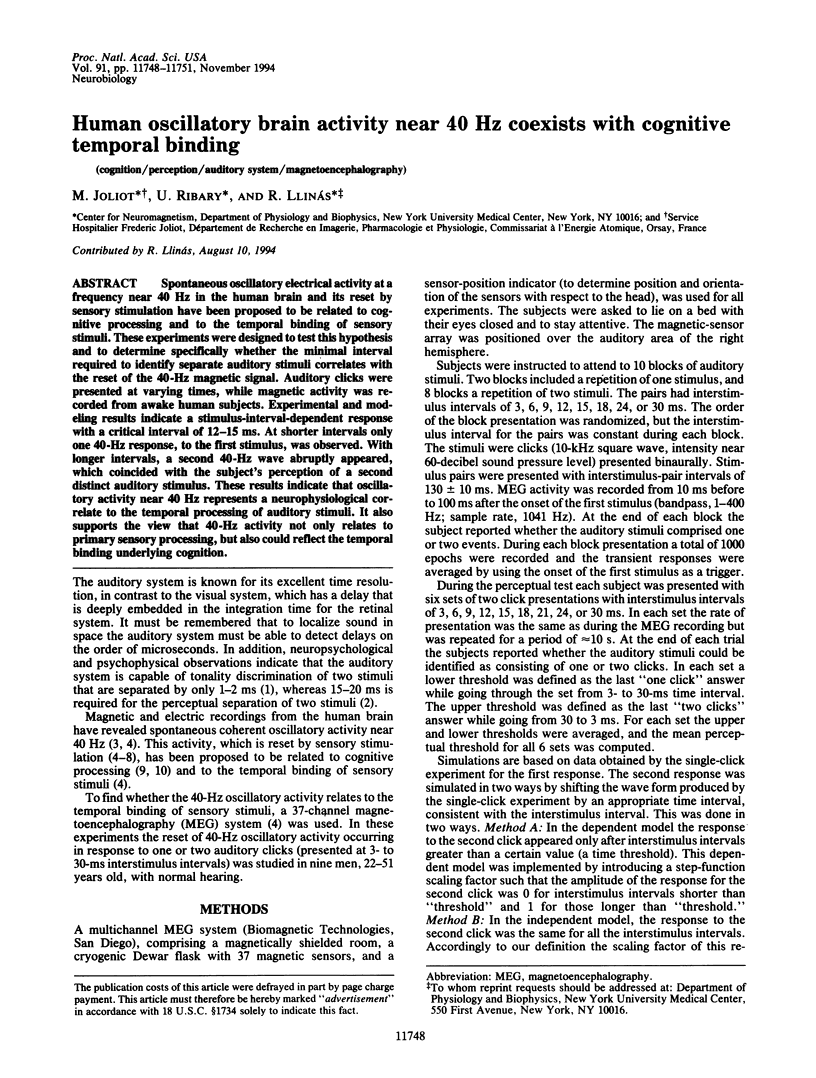
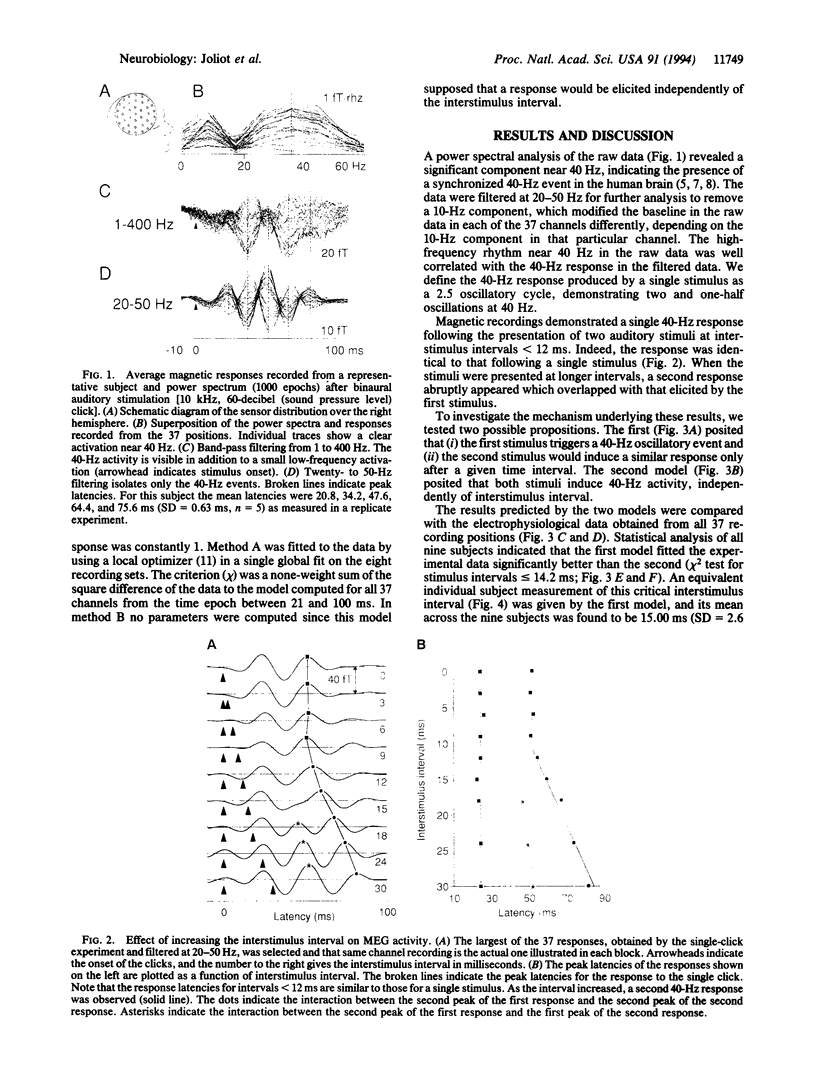
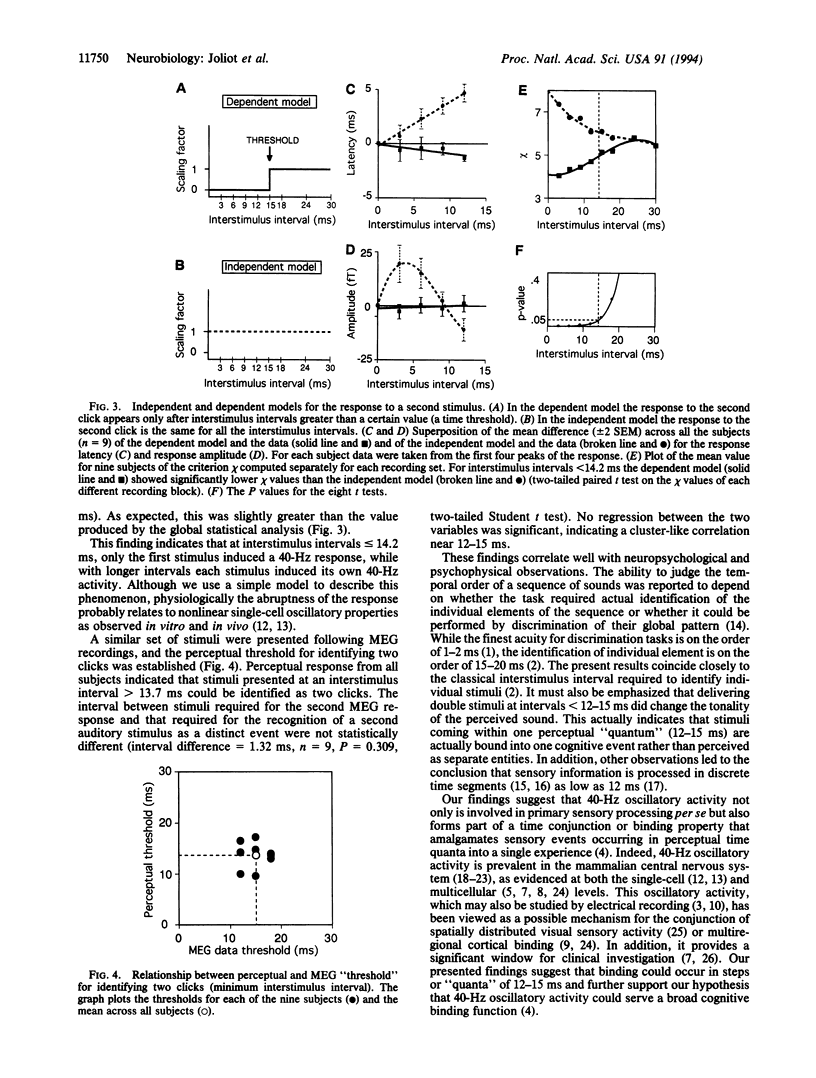
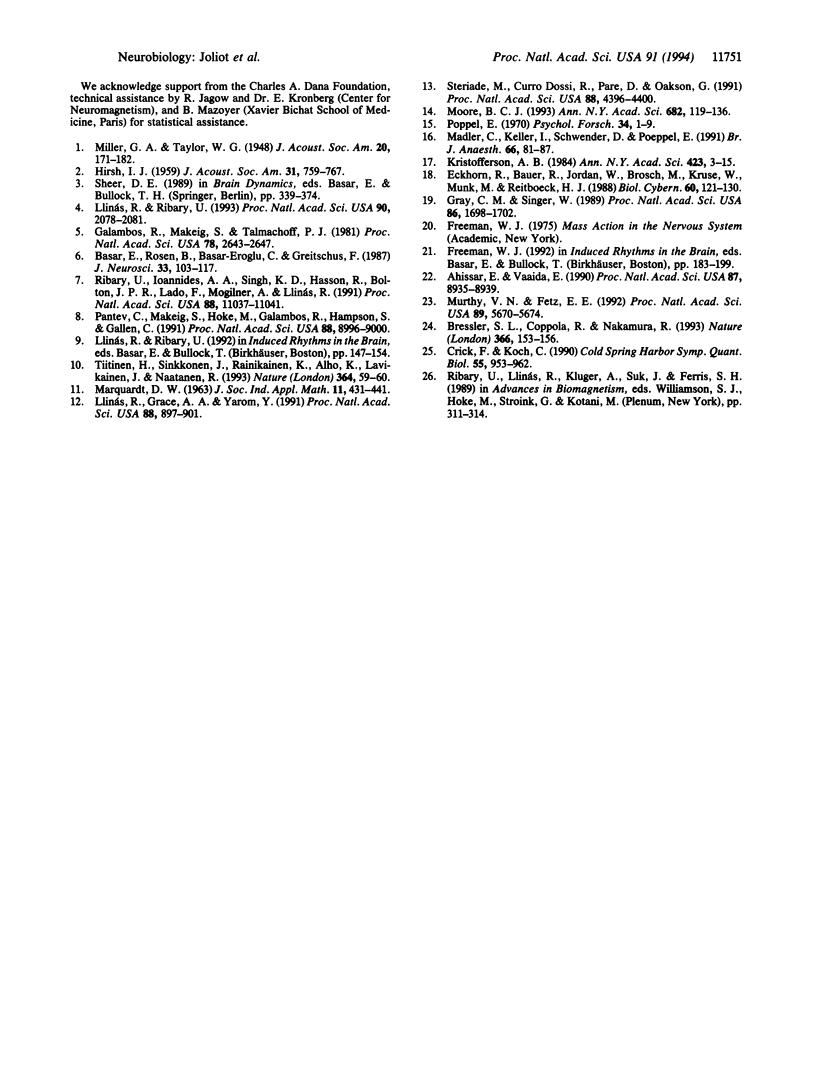
Images in this article
Selected References
These references are in PubMed. This may not be the complete list of references from this article.
- Ahissar E., Vaadia E. Oscillatory activity of single units in a somatosensory cortex of an awake monkey and their possible role in texture analysis. Proc Natl Acad Sci U S A. 1990 Nov;87(22):8935–8939. doi: 10.1073/pnas.87.22.8935. [DOI] [PMC free article] [PubMed] [Google Scholar]
- Başar E., Rosen B., Başar-Eroglu C., Greitschus F. The associations between 40 Hz-EEG and the middle latency response of the auditory evoked potential. Int J Neurosci. 1987 Mar;33(1-2):103–117. doi: 10.3109/00207458708985933. [DOI] [PubMed] [Google Scholar]
- Bressler S. L., Coppola R., Nakamura R. Episodic multiregional cortical coherence at multiple frequencies during visual task performance. Nature. 1993 Nov 11;366(6451):153–156. doi: 10.1038/366153a0. [DOI] [PubMed] [Google Scholar]
- Crick F., Koch C. Some reflections on visual awareness. Cold Spring Harb Symp Quant Biol. 1990;55:953–962. doi: 10.1101/sqb.1990.055.01.089. [DOI] [PubMed] [Google Scholar]
- Eckhorn R., Bauer R., Jordan W., Brosch M., Kruse W., Munk M., Reitboeck H. J. Coherent oscillations: a mechanism of feature linking in the visual cortex? Multiple electrode and correlation analyses in the cat. Biol Cybern. 1988;60(2):121–130. doi: 10.1007/BF00202899. [DOI] [PubMed] [Google Scholar]
- Galambos R., Makeig S., Talmachoff P. J. A 40-Hz auditory potential recorded from the human scalp. Proc Natl Acad Sci U S A. 1981 Apr;78(4):2643–2647. doi: 10.1073/pnas.78.4.2643. [DOI] [PMC free article] [PubMed] [Google Scholar]
- Gray C. M., Singer W. Stimulus-specific neuronal oscillations in orientation columns of cat visual cortex. Proc Natl Acad Sci U S A. 1989 Mar;86(5):1698–1702. doi: 10.1073/pnas.86.5.1698. [DOI] [PMC free article] [PubMed] [Google Scholar]
- Kristofferson A. B. Quantal and deterministic timing in human duration discrimination. Ann N Y Acad Sci. 1984;423:3–15. doi: 10.1111/j.1749-6632.1984.tb23413.x. [DOI] [PubMed] [Google Scholar]
- Llinás R. R., Grace A. A., Yarom Y. In vitro neurons in mammalian cortical layer 4 exhibit intrinsic oscillatory activity in the 10- to 50-Hz frequency range. Proc Natl Acad Sci U S A. 1991 Feb 1;88(3):897–901. doi: 10.1073/pnas.88.3.897. [DOI] [PMC free article] [PubMed] [Google Scholar]
- Llinás R., Ribary U. Coherent 40-Hz oscillation characterizes dream state in humans. Proc Natl Acad Sci U S A. 1993 Mar 1;90(5):2078–2081. doi: 10.1073/pnas.90.5.2078. [DOI] [PMC free article] [PubMed] [Google Scholar]
- Madler C., Keller I., Schwender D., Pöppel E. Sensory information processing during general anaesthesia: effect of isoflurane on auditory evoked neuronal oscillations. Br J Anaesth. 1991 Jan;66(1):81–87. doi: 10.1093/bja/66.1.81. [DOI] [PubMed] [Google Scholar]
- Moore B. C. Temporal analysis in normal and impaired hearing. Ann N Y Acad Sci. 1993 Jun 14;682:119–136. doi: 10.1111/j.1749-6632.1993.tb22964.x. [DOI] [PubMed] [Google Scholar]
- Murthy V. N., Fetz E. E. Coherent 25- to 35-Hz oscillations in the sensorimotor cortex of awake behaving monkeys. Proc Natl Acad Sci U S A. 1992 Jun 15;89(12):5670–5674. doi: 10.1073/pnas.89.12.5670. [DOI] [PMC free article] [PubMed] [Google Scholar]
- Pantev C., Makeig S., Hoke M., Galambos R., Hampson S., Gallen C. Human auditory evoked gamma-band magnetic fields. Proc Natl Acad Sci U S A. 1991 Oct 15;88(20):8996–9000. doi: 10.1073/pnas.88.20.8996. [DOI] [PMC free article] [PubMed] [Google Scholar]
- Pöppel E. Excitability cycles in central intermittency. Psychol Forsch. 1970;34(1):1–9. doi: 10.1007/BF00422860. [DOI] [PubMed] [Google Scholar]
- Ribary U., Ioannides A. A., Singh K. D., Hasson R., Bolton J. P., Lado F., Mogilner A., Llinás R. Magnetic field tomography of coherent thalamocortical 40-Hz oscillations in humans. Proc Natl Acad Sci U S A. 1991 Dec 15;88(24):11037–11041. doi: 10.1073/pnas.88.24.11037. [DOI] [PMC free article] [PubMed] [Google Scholar]
- Steriade M., Dossi R. C., Paré D., Oakson G. Fast oscillations (20-40 Hz) in thalamocortical systems and their potentiation by mesopontine cholinergic nuclei in the cat. Proc Natl Acad Sci U S A. 1991 May 15;88(10):4396–4400. doi: 10.1073/pnas.88.10.4396. [DOI] [PMC free article] [PubMed] [Google Scholar]
- Tiitinen H., Sinkkonen J., Reinikainen K., Alho K., Lavikainen J., Nätänen R. Selective attention enhances the auditory 40-Hz transient response in humans. Nature. 1993 Jul 1;364(6432):59–60. doi: 10.1038/364059a0. [DOI] [PubMed] [Google Scholar]



